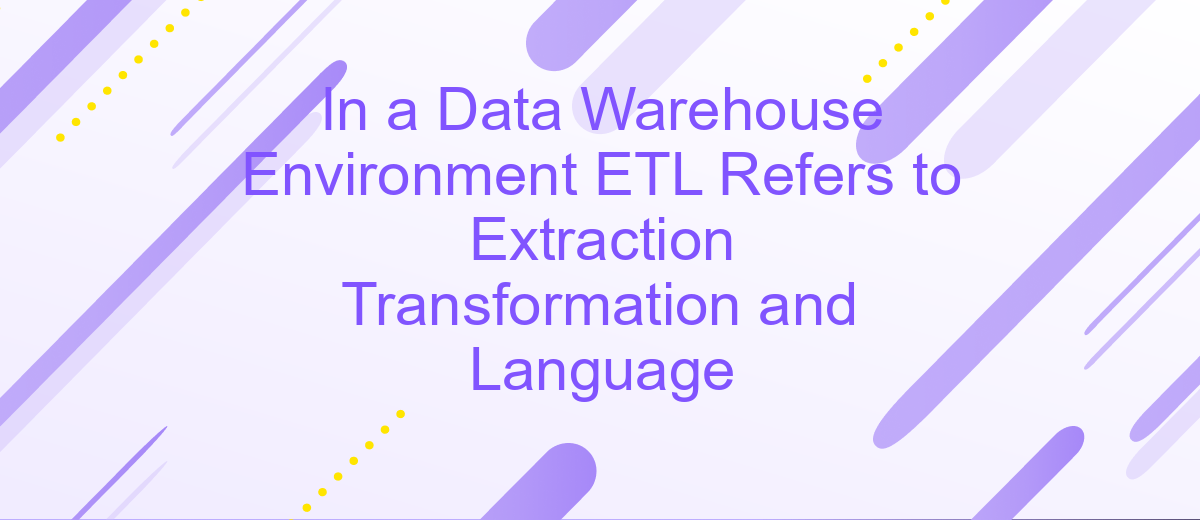In a Data Warehouse Environment ETL Refers to Extraction Transformation and Language
In the realm of data warehousing, ETL stands for Extraction, Transformation, and Loading. This critical process involves extracting data from various sources, transforming it into a suitable format, and loading it into a data warehouse. ETL ensures that data is accurate, consistent, and ready for analysis, making it indispensable for informed decision-making and business intelligence.
Introduction
In the realm of data management, a Data Warehouse Environment plays a crucial role in organizing and storing large volumes of data. ETL, which stands for Extraction, Transformation, and Loading, is a fundamental process in this environment. It involves extracting data from various sources, transforming it into a suitable format, and loading it into a data warehouse for analysis and reporting.
- Extraction: This step involves retrieving data from multiple, often heterogeneous sources.
- Transformation: In this phase, the data is cleaned, enriched, and converted into a format suitable for analysis.
- Loading: The final step where transformed data is loaded into the data warehouse.
Efficient ETL processes are essential for ensuring data quality and accessibility. Tools like ApiX-Drive can streamline these processes by automating data integration from various APIs and services, reducing manual effort and minimizing errors. As organizations increasingly rely on data-driven decision-making, mastering ETL processes becomes indispensable for maintaining a competitive edge.
Extraction

Extraction is the first step in the ETL process, where data is collected from various source systems. This data can come from a multitude of sources, including databases, cloud storage, APIs, and even flat files. The goal of extraction is to retrieve all the necessary data without causing any disruption to the source systems. This process often involves using connectors or APIs to access different data repositories, ensuring that the data is captured efficiently and accurately.
One of the tools that can facilitate this process is ApiX-Drive, which allows seamless integration with numerous applications and data sources. By using ApiX-Drive, organizations can automate the data extraction process, reducing the need for manual intervention and minimizing errors. This service supports a wide range of connectors, making it easier to pull data from disparate systems into a centralized data warehouse. Overall, efficient extraction is crucial for maintaining the integrity and reliability of the data that will undergo subsequent transformation and loading stages.
Transformation

Transformation is a critical step in the ETL process, where raw data is converted into a format that can be effectively analyzed and used for decision-making. This phase involves several sub-processes to ensure data quality and relevance.
- Data Cleaning: Removing inconsistencies, duplicates, and errors to ensure data accuracy.
- Data Integration: Combining data from various sources to provide a unified view. Tools like ApiX-Drive can simplify this by automating the integration process.
- Data Enrichment: Enhancing data by adding additional information from external sources.
- Data Aggregation: Summarizing data to provide insights at different levels of granularity.
- Data Transformation: Converting data into the required format, such as changing data types or applying business rules.
By effectively transforming data, businesses can ensure that their data warehouse contains high-quality, consistent, and relevant information. This not only facilitates accurate reporting but also supports advanced analytics and business intelligence initiatives. Utilizing services like ApiX-Drive can streamline the integration and transformation processes, making it easier to manage complex data workflows.
Loading

Loading is the final stage in the ETL process, where the transformed data is moved into the data warehouse. This step is crucial as it makes the data available for analysis and reporting. Ensuring data integrity and consistency during this phase is paramount to maintain the quality of insights derived from the data warehouse.
There are different strategies for loading data, including full load and incremental load. Full load involves loading all the data from the source system into the data warehouse, whereas incremental load only updates the data that has changed since the last load. Choosing the right loading strategy depends on the volume of data and the specific requirements of the business.
- Full Load: Suitable for smaller datasets or initial data loading.
- Incremental Load: Efficient for large datasets with frequent updates.
- Batch Loading: Data is loaded in batches at scheduled intervals.
- Real-time Loading: Data is loaded in real-time as it becomes available.
Tools like ApiX-Drive can simplify the loading process by automating data transfers between various systems. By leveraging such tools, businesses can ensure seamless data integration, reducing the risk of errors and saving valuable time. Ultimately, effective loading strategies are essential for maintaining an up-to-date and reliable data warehouse environment.
- Automate the work of an online store or landing
- Empower through integration
- Don't spend money on programmers and integrators
- Save time by automating routine tasks
Conclusion
In conclusion, the ETL process—Extraction, Transformation, and Loading—is a critical component in the data warehouse environment. It enables organizations to efficiently and accurately gather data from various sources, transform it into a usable format, and load it into a centralized repository. This structured approach ensures data integrity, enhances data quality, and provides a robust foundation for data analysis and business intelligence activities.
Moreover, the integration of advanced tools and services like ApiX-Drive can significantly streamline the ETL process. ApiX-Drive offers seamless integration capabilities, allowing businesses to automate data workflows and reduce manual intervention. By leveraging such tools, organizations can achieve greater efficiency, minimize errors, and ensure that their data warehouse remains up-to-date with the latest information. Ultimately, a well-executed ETL process is indispensable for making informed business decisions and maintaining a competitive edge in today's data-driven world.
FAQ
What is ETL in a Data Warehouse environment?
Why is ETL important for Data Warehousing?
What are the main challenges in the ETL process?
How can automation tools help in the ETL process?
What are the key components of an ETL process?
Apix-Drive will help optimize business processes, save you from a lot of routine tasks and unnecessary costs for automation, attracting additional specialists. Try setting up a free test connection with ApiX-Drive and see for yourself. Now you have to think about where to invest the freed time and money!


